Government
Fire Operations
Fire Inspector - Cpt. Patrick Strausbuagh
The on-duty Code Official can be reached at 513.678.2292 (mobile) or 513.701.6989 x1580.
All construction inspections must be scheduled 24 hours in advance with our Department and the Warren County Building Department 513.925.1290. In addition to construction inspections the Deputy Code Officials conduct annual inspection of target hazard businesses of the Township.
All full-time employees of the Department are certified as Fire Safety Inspectors and conduct annual inspections in all of the Townships commercial and educational facilities.

Public Safety Classes
CPR & First Aid Class
Learn the skills needed to possibly save a life. CPR classes are scheduled four times a year; once each quarter. Preregistration is required as class sizes are limited. Registration will begin the month prior to the class offered. Registration is done online through DeerfieldRec.com.
Fire Extinguisher Class
These classes are offered on an as needed basis depending on class size. For questions and scheduling please contact Andy Burwinkel at aburw@deerfieldtwp.com.
First Aid
These classes are offered on an as needed basis depending on class size. For questions and scheduling please contact Andy Burwinkel at aburw@deerfieldtwp.com.
Did you know?
Fire Prevention Week starts the first Sunday in October commemorating the great Chicago fire. Each year there is a new theme emphasizing different fire safety practices.
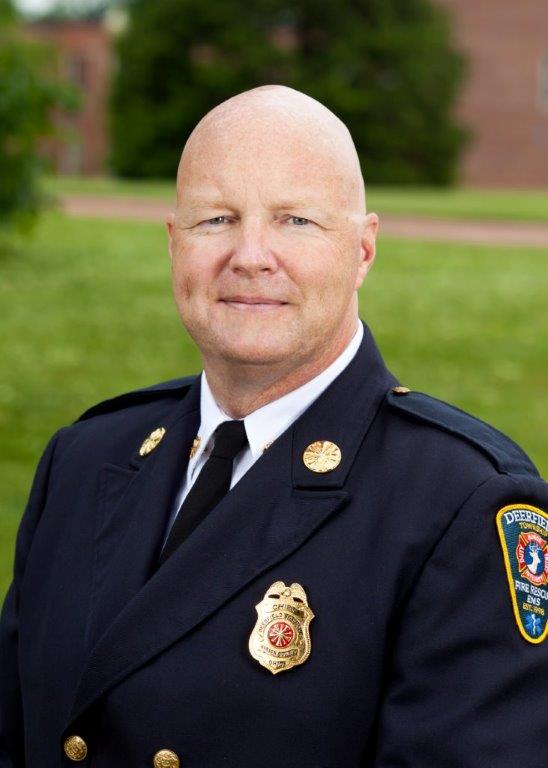
Chris Eisele, Fire Chief
Contact Information
- Phone: 513.701.6962
- Email: reise@deerfieldtwp.com
Experience
Chief Eisele began his fire service career in 1989 with the Miami Township Fire Department in Hamilton County. Chief Eisele was hired as Career Firefighter with the City of Forest Park in 1999. He was promoted to Lieutenant in 2002 and Captain in 2003. While at Forest Park, Chief Eisele began serving the citizens of Deerfield Township in December of 2000 as part-time Firefighter/Paramedic. Chief Eisele was promoted to the position of Career Battalion Chief with Deerfield in 2005 and was named Fire Chief in September 2008.
Chief Eisele graduated from Anna Marie College with a Masters of Public Administration in 2013 (Summa Cum Laude). Chief Eisele also holds a Bachelors Degree with honors in Fire Schiece from the University of Cincinnati and an Associate Degree in Fire Service Leadership from Cincinnati State Technical College where he graduated Magna Cum Laude.
Chief Eisele currently also serves as a adjunct Professor at the University of Cincinnati.
IF AN EMERGENCY DIAL 911
How Do I?
Prepare for a Fire Emergency
In less than 30 seconds, a small flame can get completely out of control and turn into a major fire. It only takes minutes for a house to fill with thick black smoke and become engulfed in flames. By preparing for a fire emergency, you can greatly reduce your chances of becoming a fire casualty.
- Install smoke alarms on every level of your home, including the basement. For extra safety, install smoke alarms both inside and outside sleeping areas.
- Test your smoke alarms once a month and change the batteries at least once a year.
- Replace smoke alarms every 8-10 years or as the manufacturer guidelines recommend.
- Plan your escape from fire. The best plans have two ways to get out of each room.
- Practice fire escape plans several times a year. Practice feeling your way out of the house in the dark or with your eyes closed.
- Purchase only collapsible escape ladders evaluated by a nationally recognized laboratory such as Underwriters Laboratory (UL).
- Check that windows are not stuck, screens can be taken out quickly, and that security bars can be properly opened.
- Make sure everyone in your family understands and practices how to properly operate and open locked or barred doors and windows.
- Consider installing residential fire sprinklers in your home.
Contact your local fire department on a non-emergency phone number if you need help or have questions about fire safety in your home.
Information provided by United States Fire Administration
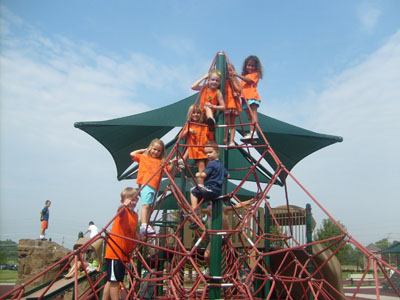
Safety Town
Safety Town is an exciting interactive day camp for children ages 4 – 6 years old. This one week experience gives children the confidence and knowledge they need to be safe at home and during the beginning of their first years in school. Each day introduces a new theme while building on skills through creative hands on learning. Our trained counselors help solidify these lessons by making safety fun and meaningful.
Community Offerings
Station Tour
Visit any one of our 3 stations.
Our stations are open to the public at all times for a tour or you may schedule a tour for a group. All events and questions can be directed to Lt. Burwinkel by phone at 513.459.0875, leave a voice mail at 513.701.6989 x1304 or by email.
Car Seat Inspection
Is your car seat installed properly? Have one of our certified technicians inspect yours today. Car seat inspections are available throughout the week and on Saturdays by appointment. For scheduling and questions contact our Car Seat Hotline at 513.701.6989 x1332. Leave a voice mail and a Technician will contact you within twenty-four hours.
Home Inspection
Home Inspections are a requirement for all adoptions and foster care homes in Warren County. You may also choose to have you home inspected for your own personal reasons. All inspections are provided at no cost to Deerfield Township residents. To schedule a home inspection phone 513-678-2292.
Open Burning Guidelines
Information below is provided by the Ohio EPA:
Full-Time Firefighter / Paramedic
Deerfield Township Fire Rescue (DTFR) is hiring firefighter/paramedics on an ongoing basis until the roster is filled. Join our crew of more than 60 dedicated professionals in safeguarding our community. The role of firefighter/paramedic involves several diverse duties including fire suppression, EMS, rescue operations, and public relations. DTFR provides top-notch training and focuses on the professional development of each employee.
Utilizing four fire stations, DTFR serves more than 40,000 residents spanning 16 square miles. The department is operated under the direction of the Fire Chief along with his command staff comprised of four Deputy Fire Chiefs who direct the daily operations of each shift. Each fire station is managed by a Captain and two Lieutenants, with a maximum staffing level of 20 per day. The organization responds to around 5,000 emergencies per year.
Submit an application, resume, and cover letter to HR Specialist Alicia Hamann at ahamann@deerfieldtwp.com. Lateral entry options for applicants with three years of full-time firefighter/paramedic experience are available.
Hiring Process:
- Submit your application, resume, and cover letter.
- Submit a valid Firefighter Mile Test or a valid CPAT Test – not required for lateral entry applicants.
- Complete EMS Patient Care Simulator Evaluation -- not required for lateral entry applicants.
- Complete Panel Interview.
- Complete Command Staff Interview.
- Pass Post-Offer Psychological Evaluation and Ohio Police and Fire Pension Physical Exam.
2025 Salary and Benefits:
- $79,847.04 Annually.
- Optional $10,812.88 available through contractual overtime hours.
- Medical, Dental, and Vision Insurance.
- Three Week Kelly Day, 48 Hour Work Week.
- 96 Hours of Holiday Time Supplemental to Allotted Vacation Hours
- Vacation Time up to 240 hours under the CBC
- 12 Hours of Sick Time Accrual per Month.
- Outside Training and College Tuition Payment
- Unrestricted Shift Trades
Minimum Qualifications:
- Valid Driver’s License
- Ohio Firefighter Level 2 Certification
- Ohio Paramedic Certification
- Ohio Fire Safety Inspector Certification within 12 months
- Hazardous Materials Technician Training within 12 months
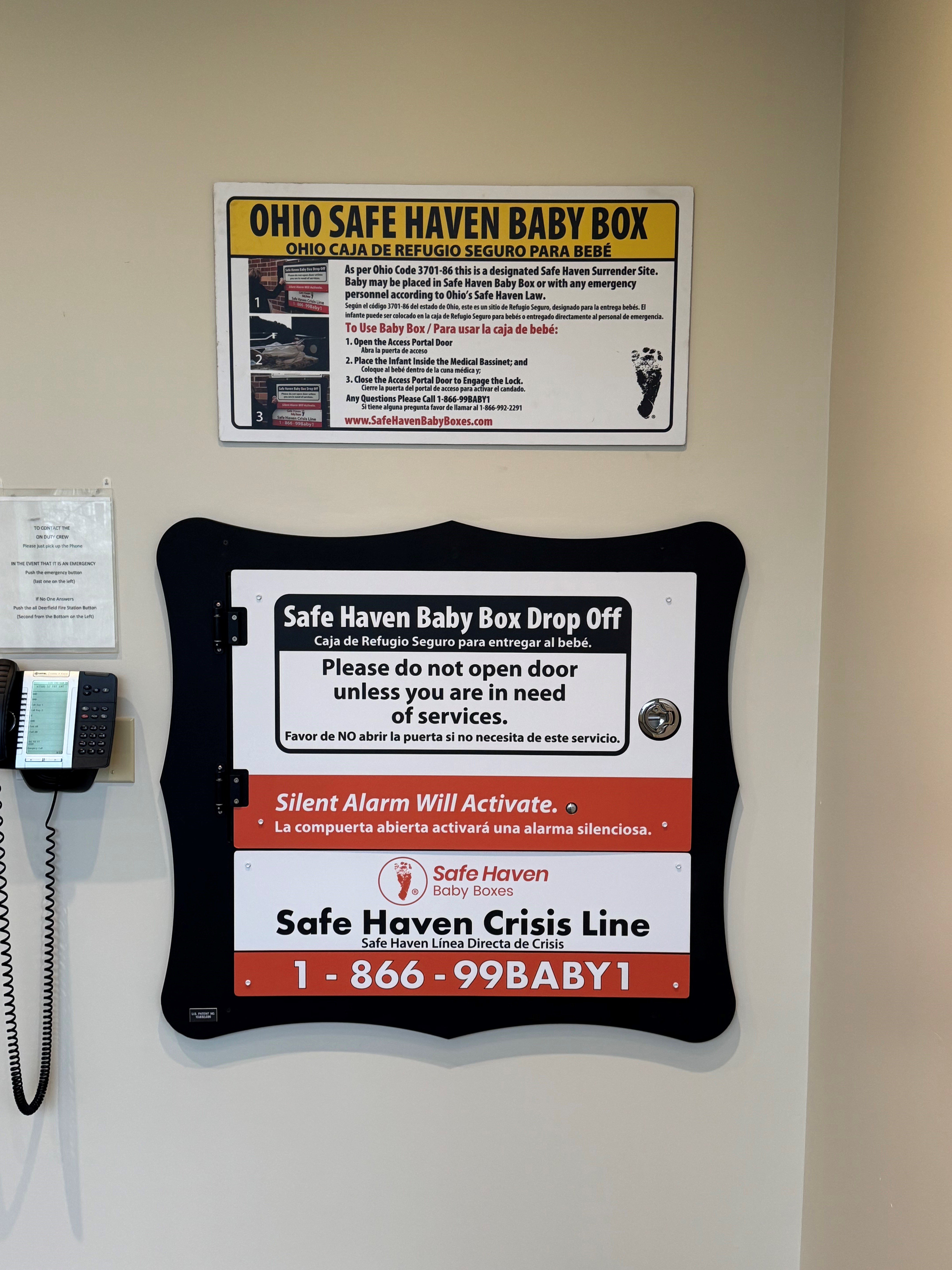
Ohio Safe Haven
Deerfield Township is proud to offer a Safe Haven Baby Box at Station 57, located at:
3435 W US Rt 22, Loveland, OH 45140
This box provides a compassionate and secure option for mothers in crisis who are unable to care for their newborns. Designed with innovative safety features and installed on the exterior walls of fire stations and hospitals, each box ensures the safe and anonymous surrender of infants.
How It Works:
- The exterior door locks automatically when a newborn is placed inside.
- An interior door allows medical personnel to promptly and securely retrieve the baby, ensuring immediate care and protection.
Why It Matters:
- The Safe Haven Baby Box at Station 57 is the 14th Baby Box in the State of Ohio and the 323rd box in the United States.
- As of March 2025, 55 infants have been safely surrendered in Safe Haven Baby Boxes.
Safe Haven Crisis Line:
1-866-99BABY1
Additional Resources:
Training Officer / EMS Officer - Lt. Joe McElroy
Phone: 513.583.4782
3435 W U.S. Route 22 & 3
Loveland, Ohio 45140
My smoke detector is chirping and I can't reach it. Who do I call to change the batteries?
If you smell smoke or are unsure please phone 911. If you need assistance changing the batteries please phone the main station number at 513.459.0875.
Matt Hannigan, Assistant Chief
- Phone: 513.583.4791
- Email: mhann@deerfieldtwp.com
Daniel James, Deputy Chief
- Phone: 513.697.2745
- Email: djame@deerfieldtwp.com
Marc Brinker, Deputy Chief
- Phone: 513.583.4795
- Email: mbrin@deerfieldtwp.com
Jason Todd, Deputy Chief
- Phone: 513.583.4780
- Email: jtodd@deerfieldtwp.com
Capt. Patrick Strausbaugh, Fire Inspector/Public Information Officer
- Phone: 513.701.6989 x1580
- Email: pstra@deerfieldtwp.com
Lt. Joe McElroy, Training Officer, EMS Officer
- Phone: 513.583.4782
- Email: jmcel@deerfieldtwp.com
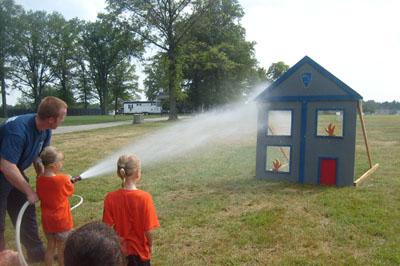
What Your Child Will Experience
Each day begins by getting the creative energy flowing in the art room while we wait for everyone to arrive. On the first day of the week the children are assigned counselors and remain in the same group for the entire week building their comfort and confidence. Once everyone is there all the groups are escorted to the main room for a special guest speaker covering the theme of the day. Themes include Police Officers Are Our Friends, Bicycle Safety, Pet and Animal Safety, Bus Safety and Fire Safety.
After listening to the guest speaker the children rotate through five different stations. These stations remain constant throughout the week except for Friday. Each station usually lasts approximately 15 minutes and reinforces their skills as well as a much needed energy outlet. Each group rotates through every station once each day.
The day concludes when all of the groups have rotated through each of the stations and we all meet in the main room. Our helmets and snack bags are gathered and we talk about what we learned from our guest speaker concerning the theme for that day. Goodie bags are given out that contain a reward and information focused on the theme of the day. Children are then released to their parents as we eagerly await the next day of fun and learning about safety.
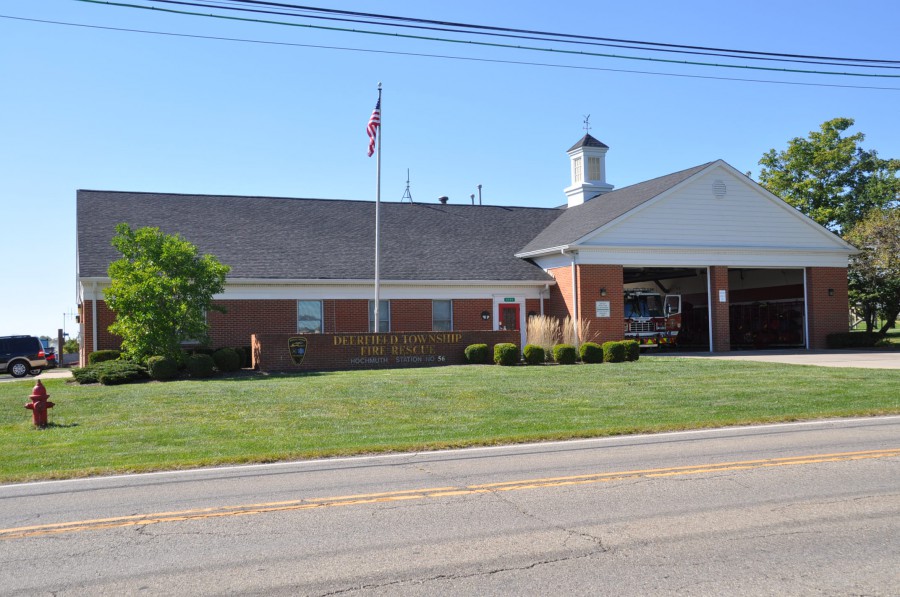
Fire Station 56 | 513.398.0169 option 2
Location: 8395 Snider Road, Mason, OH 45040
Station 56 staffs an Engine Company and an ALS Ambulance (Medic Unit). Station 56 protects the Socialville region of Deerfield Township, from our southern and western borders to the city corporation line and Interstate 71. Station 56 services all Deerfield Township sub-divisions off of Butler-Warren Road and south of Tylersville Road.
Apparatus for 56
- Engine
- Ambulance
.jpg)
Why is open burning a problem?
Open burning can release many kinds of toxic fumes. Leaves and plant materials send aloft millions of spores when they catch fire, causing many people with allergies to have difficulty breathing. The pollutants released by open burning also make it more difficult to meet health-based air quality standards, especially in or near large cities. The gases released by open burning can also corrode metal siding and damage paint on buildings.
What open burning is never allowed? Under Ohio law, these materials may not be burned anywhere in the state at any time:
- garbage—any wastes created in the process of handling, preparing, cooking or consuming food;
- materials containing rubber, grease and asphalt or made from petroleum, such as tires, cars and auto parts, plastics or plasticcoated wire; and
- dead animals—unless approved for control of disease by a governing agency.
Other restrictions:
- Open burning is not allowed when air pollution warnings, alerts or emergencies are in effect.
- Fires cannot obscure visibility for roadways, railroad tracks or air fields.
- No wastes generated off the premises may be burned. For example, a tree trimming contractor may not haul branches and limbs to another site to burn.
Does Ohio EPA ever allow exceptions to the rules?
Under certain circumstances, yes. However, to burn a prohibited material or set a fire in a restricted area, you must receive written permission from Ohio EPA before you begin burning. This may take two weeks.
What happens if I’m caught illegally open burning?
Ohio EPA has the authority to enforce the state’s open burning laws. Violations can result in substantial penalties. If you have any questions, or would like to report a suspected open burning incident, contact your Ohio EPA district office or your local air pollution control agency.
Health Concerns
Burning household waste produces many toxic chemicals and is one of the largest known sources of dioxin in the nation. Other air pollutants from open burning include particulate matter, sulfur dioxide, lead and mercury. These pollutants have been linked to several health problems, including asthma, respiratory illnesses, nervous system damage, kidney and liver damage, and reproductive or developmental disorders.
More information can be found at the links below:
Fire Station 56 | 513.398.0169 option 2
Location: 8395 Snider Road, Mason, OH 45040
Station 56 staffs an Engine Company and an ALS Ambulance (Medic Unit). Station 56 protects the Socialville region of Deerfield Township, from our southern and western boarders to the city corporation line and Interstate 71. Station 56 also services all Deerfield Township sub-divisions off of Butler Warren Road and those south of Mason Road.
Recycling bins are located here and at Station 58
Apparatus for 56
- Engine
- Ambulance
- Public Education Trailer
Registration Information
Four sessions of Safety Town are offered in June each year; registration begins on May 1st for Deerfield Township residents.
Deerfield Township residents are eligible to register their children in any one of the two sessions offered at no cost. Safety Town has limited availability and we would like to provide everyone with the same opportunity to be a part of this event.
For more about Safety Town dates and registration please go to DeerfieldRec.com.
If you have any questions, please email Michael Dulovich at mdulo@deerfieldtwp.com.
Seasonal Reminders - Every season brings about new cautions and awareness pertaining to fire and safety. Please read up to stay informed and be safe throughout the year. Click here to read seasonal reminders.
Spring
Check your Clocks and Batteries
It's time for a change! Change your clocks and batteries...
When it’s time to "spring forward" and change the clocks, make sure to change the batteries in all of your smoke alarms. If batteries were recently changed, it's still very important to conduct your monthly test of your smoke alarms. It could save a life! Did you know that having a working smoke alarm reduces a person's chance of dying in a fire by half? For the best protection, install smoke alarms on every level of your home, outside every sleeping area and in every bedroom. Smoke alarms should be mounted high on walls or ceilings and tested monthly. It's important to replace smoke alarm batteries at least once a year, unless they're 10 year lithium batteries. Even if your smoke alarms are hardwired, replace the batteries in case of a chirping sound or a power outage. Reminder: Smoke alarms do not last forever. The maximum life span is 8-10 years. After that time, the entire unit should be replaced. If the unit does not respond properly when tested, it should be replaced immediately.
Spring Cleaning
Try these safety techniques to prevent spring cleaning injuries:
- Remember to take frequent breaks and stay hydrated as you complete your cleaning project.
- Get help for moving heavy furniture.
- Clean the floor with a mop rather than on your hands and knees. Push the mop forward and back to clean small areas at a time, rather than leaning too far forward.
- If you must scrub floors by hand, kneel on a pad and don’t reach too far in any direction.
- Vacuuming can put a lot of strain on the spine and neck. Keep the hose in front of your body at waist height, use both hands to push the vacuum, and walk straight across the carpet, then turn and go back. Avoid pushing and pulling in short little strokes.
- For bathtub cleaning, stand outside the tub with a long mop rather than sitting and leaning over the side.
- If you're washing high windows, use a secure ladder or step stool to stay level with the window rather than stretching your back and neck upwards for long periods of time. The same goes for painting.
- Lift items such as mulch, flower pots and other heavy objects by bending your knees and lifting with your legs rather than your back. Keep items close to your body and use both hands.
- Pull weeds with your legs and abdominal muscles tightened .
- Spring cleaning can be great exercise. Consider it a workout instead of work!
Summer
Memorial Day and Fourth of July
Ohio’s New Fireworks Law (July 1, 2022)
Fireworks Safety
- The only types of fireworks that can be legally purchased and discharged in Ohio are trick and novelty devices. These include items that smoke, sparkle, snap and snake.
- Handle and discharge trick and novelty devices only under adult supervision.
- Appoint one adult to be in charge. This person should know the hazards of each type of firework being used.
- Carefully read and follow the label directions on the trick and novelty device packaging.
- Light only one sparkler at a time and hold it away from your body and others.
- Sparkler wires, which can burn up to 1800 degrees, should immediately be placed in a bucket of water to avoid injury as they remain hot for a few minutes after burnout.
- If someone gets burned, run cool water over the wound for two or three minutes and seek medical attention when necessary.
Campfire Safety
- Build where they will not spread; away from dry grass, leaves and never under overhanging trees.
- Keep campfires small, and don’t let them get out of hand.
- Keep plenty of water and a shovel around to douse the fire when you’re done. Stir it and douse it again with water.
- Never leave campfires unattended.
- It is important to follow the park’s rules for the use and extinguishing of campfires.
- Never start a without having the equipment and ability to extinguish it.
Barbecue Safety
- Before using a grill, check the connection between the propane tank and the fuel line.
- Do not overfill the propane tank.
- Do not wear loose clothing while cooking at a barbecue.
- Be careful when using lighter fluid. Do not add fluid to an already lit fire because the flame can flashback up into the container and explode.
- Keep all matches and lighters away from children. Teach your children to report any loose matches or lighters to an adult immediately. Supervise children around outdoor grills.
- Dispose of hot coals properly - douse them with plenty of water, and stir them to ensure that the fire is out. Never place them in plastic, paper or wooden containers.
- Never grill/barbecue in enclosed areas - carbon monoxide could be produced.
- Make sure everyone knows to Stop, Drop and Roll in case a piece of clothing does catch fire. Call 911 or your local emergency number if a burn warrants medical attention. All burns to the face, hands, feet or groin require medical attention.
Fall
Halloween Safety
Walk Safely
- Cross the street at corners, using traffic signals and crosswalks.
- Look left, right and left again when crossing and keep looking as you cross.
- Put electronic devices down and keep heads up and walk, don’t run, across the street.
- Teach children to make eye contact with drivers before crossing in front of them.
- Always walk on sidewalks or paths. If there are no sidewalks, walk facing traffic as far to
the left as possible. Children should walk on direct routes with the fewest street crossings. - Watch for cars that are turning or backing up. Teach children to never dart out into the street or cross between parked cars.
Trick or Treat With an Adult
- Children under the age of 12 should not be alone at night without adult supervision. If kids are mature enough to be out without supervision, they should stick to familiar areas that are well lit and trick-or-treat in groups.
Keep Costumes Both Creative and Safe
- Decorate costumes and bags with reflective tape or stickers and, if possible, choose light colors.
- Choose face paint and makeup whenever possible instead of masks, which can obstruct a child’s vision.
- Have kids carry glow sticks or flashlights to help them see and be seen by drivers.
- When selecting a costume, make sure it is the right size to prevent trips and falls.
Drive Extra Safely on Halloween
- Slow down and be especially alert in residential neighborhoods. Children are excited on Halloween and may move in unpredictable ways.
- Take extra time to look for kids at intersections, on medians and on curbs.
- Enter and exit driveways and alleys slowly and carefully.
- Eliminate any distractions inside your car so you can concentrate on the road and your surroundings.
- Drive slowly, anticipate heavy pedestrian traffic and turn your headlights on earlier in the day to spot children from greater distances.
- Popular trick-or-treating hours are 5:30 p.m. to 9:30 p.m. so be especially alert for kids during those hours.
Winter
Carbon Monoxide
Often called the invisible killer, carbon monoxide (CO) is an odorless, colorless gas created when fuels such as gasoline, wood, coal, propane, etc. do not burn completely. In the home, heating and cooking equipment that burn fuel are potential sources of CO. Carbon monoxide incidents are more common during the winter months, and in residential property.
Winter Storms
Most of the U.S. is at risk for winter storms, which can cause dangerous and sometimes life-threatening conditions. Blinding wind-driven snow, extreme cold, icy road conditions, downed trees and power lines can all wreak havoc on our daily schedules. Home fires occur more in the winter than in any other season, and heating equipment is involved in one of every six reported home fires, and one in every five home fire deaths.
Generators
Portable generators are useful during power outages, however, many homeowners are unaware that the improper use of portable generators can be risky. The most common dangers associated with portable generators are carbon monoxide (CO) poisoning, electrical shock or electrocution, and fire hazards. According to a 2013 Consumer Product Safety Commission report, half of the generator-related deaths happened in the four coldest months of the year, November through February, and portable generators were involved in the majority of carbon monoxide deaths involving engine-driven tools.
Candles
December is the peak time of year for home candle fires; the top three days for home candle fires are Christmas, New Year’s Day, and New Year’s Eve. Each year between 2012 and 2016, an average of 8,200 home candle fires were reported each year. More statistics on candle fires.
Electrical
Electrical home fires are a leading cause of home fires in the U.S. Roughly half of all home electrical fires involved electrical distribution or lighting equipment, while nearly another half involved other known types of equipment like washer or dryer fans, and portable or stationary space heaters
Heating
In 2011-2015, heating equipment was involved in an estimated 54,030 reported U.S. home structure fires, with associated losses of 480 civilian deaths, 1,470civilian injuries, and $1.1 billion in direct property damage. These fires accounted for 15% of all reported home fires.
Facts & Figures
Based on 2011-2015 annual averages:
- Space heaters, whether portable or stationary, accounted for just over two of every five (43%) of home heating fires and four out of five (85%) of home heating fire deaths.
- The leading factor contributing to home heating fires (28%) was failure to clean, principally creosote from solid-fueled heating equipment, primarily chimneys.
- Placing things that can burn too close to heating equipment or placing heating equipment too close to things that can burn, such as upholstered furniture, clothing, mattress, or bedding, was the third leading factor contributing to ignition in fatal home heating fires and accounted for more than half (53%) of home heating fire deaths.
- Keep anything that can burn at least 3ft from heating equip (furnace, fireplace, wood stove, portable heater)
- Nearly half (48%) of all home heating fires occurred in December, January and February.
- Inspect and maintain heating equipment regularly for safety.
- Be sure to have fixed space heaters installed by a qualified technician, according to manufacturer’s instructions or applicable codes. Or, make sure a qualified technician checks to see the unit has been properly installed.
- When buying a new, portable space heater, make sure it has the label showing it is listed by a recognized testing laboratory, such as Underwriters Laboratories (UL).
- Space heaters should be turned off every time you leave the room and before going to bed.
- Choose space heaters that turn off automatically if they tip over.
- Never use a space heater to dry clothing.
- Do not use your oven to heat your home.
- Install smoke alarms in every bedroom, outside each sleeping area, and on every level of the home. For the best protection, interconnect all smoke alarms throughout the home. When one sounds, they all sound.
- Test smoke alarms monthly.
Fire Station 57 | 513.697.2744 option 2
Location: 3435 U.S. Route 22 & 3, Loveland, OH 45140
Station 57 staffs a Ladder Company and an ALS Ambulance (Medic Unit). Station 57 protects Loveland Park, Landen, and the Maineville portion of Deerfield Township, from our southern and eastern boarders to Western Row. Ladder 57 crew also cross staffs our Technical Rescue Unit. Station 57 is the Department’s Headquarters, housing the Fire Chief and Battalion Chiefs, in addition to support services and the Department’s fleet maintenance facility.
Check out the design-build process through our Deerfield Township Youtube channel here at the Township.
Recycling bins are located at Station 56 & Station 58
Apparatus for 57
- Ladder Truck
- Engine
- Two Ambulances
- Rescue Truck
- Hazmat Trailer
How do I reach the Fire Department for non-emergency questions and scheduling?
513.459.0875
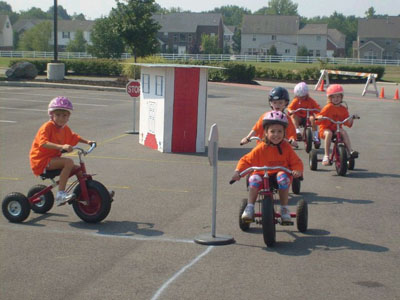
Themes
- Monday: Bike Safety
- Tuesday: Police Officers are our Friends
- Wednesday: Bus Safety
- Thursday: Pet Safety
- Friday: Fire Safety
Daily Stations
Station One: Safety Town Tricycles
Children practice riding their tricycles through the streets of Safety Town. Wearing their bicycle helmets they learn hand signals and the rules of the road.
Station Two: Snack Time
After navigating the streets of Safety Town safely it is time for a snack. Children bring a light snack while they rest and watch a safety video geared toward the theme of the day.
Station Three: 9-1-1 Phones
This is where the children learn to dial 9-1-1 and talk to a live (counselor) operator. We practice writing out our name, address and phone number then call 9-1-1 and repeat our information so the operator can send help.
Station Four: Playground
After saving the day by calling 9-1-1 it is time to celebrate and play on the playground while practicing all of our safety rules.
Station Five: Creative Art
The theme of the day is expressed in your child’s
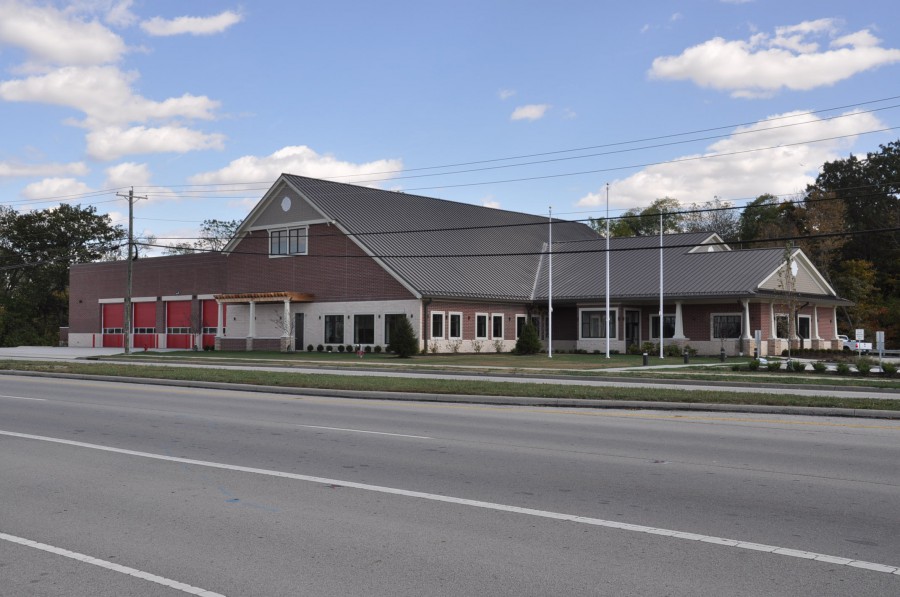
Fire Station 57 | 513.697.2744 option 2
Location: 3435 U.S. Route 22 & 3, Loveland, OH 45140
Station 57 staffs a Ladder Company and an ALS Ambulance (Medic Unit). Station 57 protects Loveland Park, Landen, and the Maineville portion of Deerfield Township, from our southern and eastern boarders to Western Row. Ladder 57 crew also cross staffs our Heavy Rescue Unit and a Regional Hazardous Material Unit. Station 57 is the Department’s Headquarters, housing the Fire Chief and Deputy Chiefs.
Station 57 now offers the Ohio Safe Haven Baby Box.
Check out the design-build process through our Deerfield Township Youtube channel here at the Township.
Apparatus for 57
- Ladder Truck
- Engine
- Ambulances
- Rescue Truck
- Hazmat Trailer
How do I get the Fire Department to inspect my business?
Please phone 513.678.2292 to schedule an inspection for your business.
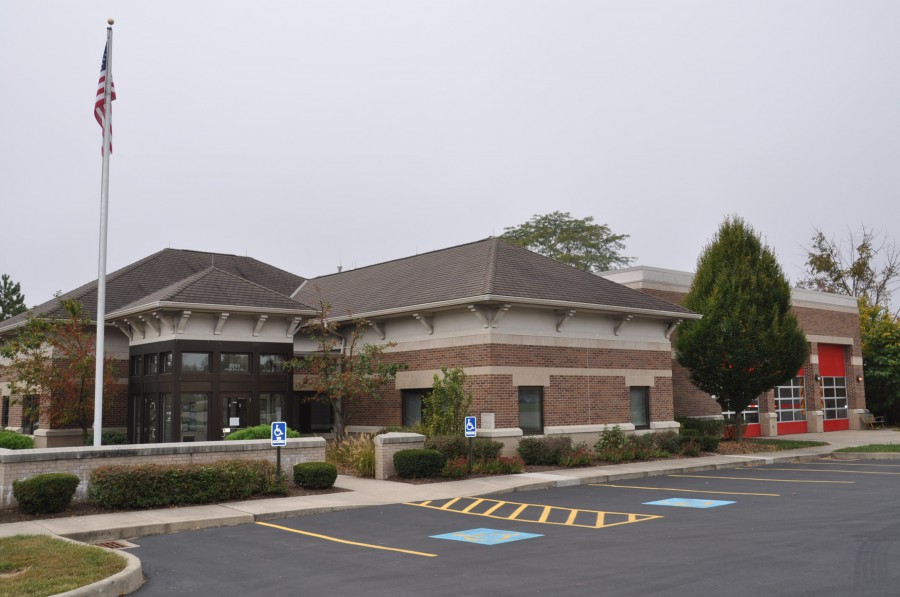
Fire Station 58 | 513.339.0558 option 2
Location: 2095 Kings Mills Road, Mason, OH 45040
Station 58 staffs an Engine Company and an ALS Ambulance (Medic Unit). Station 58 protects Kings Mills and through agreement with City of Mason is the first due ambulance and Engine Company to all areas of Mason, north of Kings Island and off of State Route 741.
Apparatus for 58
- Engine
- Ambulance
Seasonal Holiday Safety Tips
With the holidays in full swing, it’s important to remember we want to Keep the Wreath Red, a safety program Deerfield Township Fire Rescue will once again promote this year to remind residents that fires are often caused by holiday decorations.
Beginning in December each of our four township fire stations will display a wreath decorated with illuminated red bulbs. If a fire is caused directly by holiday decorations, one red bulb will be changed to a white bulb. Since 2012 all of our wreaths have stayed red. Please help us keep this tradition in the red.
Keep the Wreath Red originated in Illinois by Napervillle Firefighter Paul Boecker during the holiday season of 1954. Each year more fire departments across the country have joined in to make the holidays safer and happier. Deerfield Township Fire Rescue encourages everyone to follow these safety tips during the holidays from the National Fire Protection Association (NFPA)
Safety Tips for the Season
Christmas Trees
Type of tree
Consider an artificial tree, which is much safer and cleaner.
Select only fresh trees that are deep green in color, have a strong scent of pine, and do not lose their needles readily.
Keep trees in water-holding stands and keep stands full of water.
Do not rely on chemical sprays to make your tree flame resistant.
Place trees away from heat sources and a safe distance from exits.
Lights
Maintain Your Holiday Lights
Inspect holiday lights each year for frayed wires, bare spots, gaps in the insulation, broken or cracked sockets, and excessive kinking or wear before putting them up. Use only lighting listed by an approved testing laboratory.
Do Not Overload Electrical Outlets
Do not link more than three light strands, unless the directions indicate it is safe. Connect strings of lights to an extension cord before plugging the cord into the outlet. Make sure to periodically check the wires – they should not be warm to the touch.
Discard any lights that have frayed or worn cords, broken or cracked sockets,
loose connections, bare wires or operate intermittently.
Buy and use lights approved by a national testing laboratory.
Do not leave holiday lights on unattended!
Holiday Decorations
Use Only Nonflammable Decorations
All decorations should be nonflammable or flame-retardant and placed away from heat vents. If you are using a metallic or artificial tree, make sure it is flame retardant.
Never Put Lit Candles on a Tree
Do not go near a Christmas tree with an open flame – candles, lighters or matches.
Don't Block Exits
Ensure that trees and other holiday decorations do not block an exit way. In the event of a fire, time is of the essence. A blocked entry/exit way puts you and your family at risk.
Never Put Wrapping Paper in the Fireplace
Wrapping paper in the fireplace can result in a very large fire, throwing off dangerous sparks and embers that may result in a chimney fire.
Candle Care
Never Leave a Burning Candle Unattended
Consider using battery-operated flameless candles, which can look, smell and feel like real candles.
If You Do Use Lit Candles
Make sure candles are in stable holders and place them where they cannot be easily knocked down. Keep candles at least 12 inches from anything that can burn. Avoid using candles in bedrooms and sleeping areas.
Disposing of Your Tree
Never put tree branches or needles in a fireplace or wood-burning stove. When the tree becomes dry, discard it promptly. The best way to dispose of your tree is by taking it to a recycling center or having it hauled away by a community pick-up service.
Flood Safety - Most communities in the United States can experience some kind of flooding after spring rains, heavy thunderstorms or winter snow thaws. Floods can be slow or fast-rising, but generally develop over a period of days. Flash floods usually result from intense storms dropping large amounts of rain within a brief period. Flash flooding can occur with little or no warning and can reach its peak in only a few minutes.
Emergency Information
Flood waters can be extremely dangerous. The force of six inches of swiftly moving water can knock an adult person off his or her feet. The best protection during a flood is to leave the area and seek shelter on higher ground.
Flash flood waters move very quickly and can roll boulders, tear out trees, destroy buildings and obliterate bridges. Walls of water can reach heights of 10 to 20 feet and generally are accompanied by a deadly cargo of debris. The best response to any signs of flash flooding is to move immediately and quickly to higher ground.
Just two feet of moving water can float and carry away most vehicles, including sport utility vehicles (SUVs) and pickup trucks. You can protect yourself best by being prepared and having time to act.
Before a Flood
- Check with your local floodplain administrator to determine if you live in a flood-prone area.
- Consider installing check valves in building sewer traps to prevent flood waters from backing up in sewer drains.
- Plan and practice an evacuation route.
- Have disaster supplies on hand.
- Develop an emergency communication plan.
- Flood damage to vehicles is covered by auto insurance when comprehensive coverage is purchased.
During a Flood Watch
- Listen to a radio or television for the latest storm information.
- Fill bathtub, sinks and jugs with clean water in case water becomes contaminated.
- Move valuable household possessions to upper floors or to safe grounds if time permits.
- If you are instructed by local authorities, turn off all utilities at the main power switch and close the main gas valve.
- Be prepared to evacuate.
During a Flood Warning
- If indoors, turn on a battery-powered radio or NOAA Weather Radio to get the latest emergency information. If your area is advised to evacuate, do so immediately.
- If outdoors, climb to high ground and stay there. Avoid walking through any flood waters.
- If you are driving and have come to a flooded area, turn around and go the other way. Many deaths have resulted from attempts to drive through flooded roadways.
During an Evacuation
- If advised to evacuate, do so immediately.
- Evacuation is much simpler and safer before flood waters block your escape. Leave early enough to avoid being marooned by flooded roads.
- Never attempt to drive or walk through flood waters. Water could be deeper than it appears and floodwater currents can be deceptive. Remember, it only takes two feet of water to carry away most vehicles.
- Listen to Emergency Alert System (EAS) messages on the radio or television for evacuation instructions
- Follow recommended evacuation routes. Shortcuts may be blocked.
After a Flood
The hours immediately following a flood can be very confusing. When disaster strikes, the county emergency management agency and local government initiate rescue, evacuation and shelter missions and provide emergency assistance to meet the public’s immediate needs.
If the commissioners declare a state of emergency for the county, the local EMA may contact the Ohio EMA for assistance in coordinating state resources and response activities. Based on the extent of the incident, the governor may declare a state of emergency for the affected county(ies). If disaster damages exceed state and local capabilities, the governor may request the president to grant federal disaster assistance through FEMA.
- Before entering a flood-damaged building, check the foundation for cracks and inspect porch roofs and overhangs to be sure they are adequately supported. Ask a building inspector to check the house before you go inside.
- Be alert for gas leaks. Do not strike a match or use open flame when entering a building unless you know the gas has been turned off and the area ventilated.
- Do not use appliances or motors that have gotten wet unless they have been taken apart, cleaned and dried.
- For more information on floods or flood safety, contact your state or local emergency management agency; the Ohio Department of Natural Resources, Division of Water; the National Weather Service; or your local American Red Cross chapter.
For additional information on Ohio flooding and flood insurance, visit the following sites:
- FloodSmart.gov
- Ohio Insurance Institute
- Ohio Department of Insurance
- Ohio Department of Natural Resources, Floodplain Management
- Federal Emergency Management Agency
Additional Flood Safety Tips
- Evacuate areas that are subject to flooding. This includes dips, low spots, canyons,
washes, etc. - If driving, be aware that the road bed may not be intact under flood waters. Turn around
and go another way. NEVER drive through flooded roads or low water crossings. Rapidly rising waters may engulf the vehicle and sweep it away. - If camping, choose camp sites along waterways with care. Remember that storms that are miles away could bring raging water your way.
Flood Terminology
Flood – A condition that occurs when water overflows the natural or artificial confines of a stream or body of water, or accumulates by drainage over low-lying areas.
General River Flooding – follows heavy rain, snow melt or their combination. While river flooding typically occurs slowly, allowing more time to take protective measures, extreme flash flooding or a breakup of an ice jam along a river can produce more rapid river rises.
Urban and Small Stream Floods – occurs when heavy rain falls, resulting in flooded streets, underpasses or drainage ditches in urban areas, and creeks in rural areas. Not usually life-threatening on its own, but can be, if motorists drive through a flooded roadway or children play near a storm drain or drainage ditch.
Flash Floods – Rapid and life-threatening floods from heavy rains occurring in a short period of time, usually in hilly or mountainous areas, or produced by the failure of a dam.
Flood/Flash Flood Watch – Usually issued for several hours indicating that conditions are favorable for possible flooding or flash flooding.
Flood/Flash Flood Warning – Issued when flooding or flash flooding is imminent or occurring. This indicates a need to take protective measures.
Fire Station 58 | 513.339.0558
Location: 2095 Kings Mills Road, Mason, OH 45040
Station 58 staffs an Engine Company and an ALS Ambulance (Medic Unit). Station 58 protects Kings Mills and through agreement with City of Mason is the first due ambulance and Engine Company to all areas of Mason, north of Kings Island and off of State Route 741. Also housed at Station 58 is MCU-158, a 100 person Mass Casualty Treatment Unit and part of UASI.
Recycling Bins are located here and at Station 56.
Apparatus for 58
- Engine
- Ambulance
- MCU 158
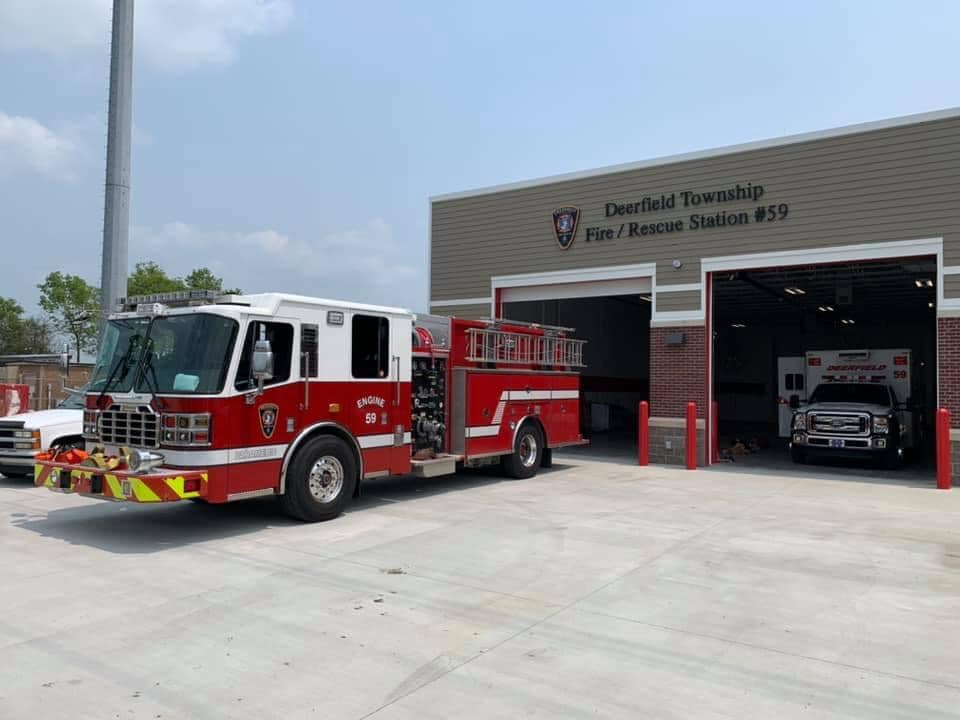
Fire Station 59 | 513.770.2388 option 2
Location: 3650 Butler Warren Rd, Mason, OH 45040
Station 59 staff an Engine Company and an ALS Ambulance (Medic Unit). Station 59 protects the northwest portion of the Township, including all areas north of Tylersville Road to Brewer Road and Butler Warren Rd to Mason-Montgomery Road.
Apparatus for 59
- Engine
- Ambulance
Carbon Monoxide Safety - Carbon monoxide (CO) is a tasteless, odorless, and colorless gas known as the “silent killer.” Each year, more than 400 Americans die from unintentional CO poisoning, more than 20,000 visit the emergency room and more than 4,000 are hospitalized due to CO poisoning.
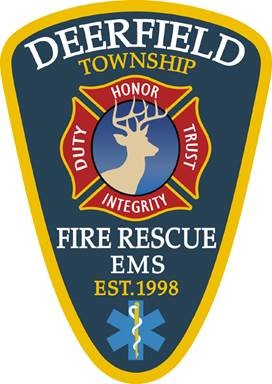
Deerfield Township Fire Rescue
The Deerfield Township Fire Rescue Department (DTFR) is committed to providing the highest level of customer service and resources to our community and members. We save lives and protect property through fire suppression, emergency medical services (EMS), all-hazards incident management, and community risk reduction efforts. We operate out of four strategically located fire stations that are staffed by 63 career firefighter/paramedics and 5 part-time firefighter/paramedics, responding to over 5,000 emergency calls for service annually.
Mission Statement
The Deerfield Township Fire Rescue Department’s mission is to protect the quality of life for present and future generations through interaction with our community, compassionate service, and an atmosphere that encourages duty, honor, trust, and integrity.
Vision Statement
It is the vision of the Deerfield Township Fire Rescue Department to continue to grow and adapt to our ever changing community, and to provide the highest level of public safety services to our citizens.
Heating Safety - FIRST AND FOREMOST: Having a working smoke alarm dramatically increases your chances of surviving a fire. And remember to practice a home escape plan frequently with your family.
Fireplaces
Fireplaces regularly build up creosote in their chimneys. They need to be cleaned out frequently and chimneys should be inspected for obstructions and cracks to prevent deadly chimney and roof fires. Check to make sure the damper is open before starting any fire. Never burn trash, paper or green wood in your fireplace. These materials cause heavy creosote buildup and are difficult to control. Use a screen heavy enough to stop rolling logs and big enough to cover the entire opening of the fireplace to catch flying sparks. Don't wear loose-fitting clothes near any open flame. Make sure the fire is completely out before leaving the house or going to bed. Allow ashes to cool before disposing of them. Place ashes in a tightly covered metal container and keep the ash container at least 10 feet away from your home and any other nearby buildings. Never empty the ash directly into a trash can. Douse and saturate the ashes with water.
Wood Stoves
Wood stoves cause over 4,000 residential fires every year. Carefully follow the manufacturer's installation and maintenance instructions. Look for solid construction, such as plate steel or cast iron metal. Check for cracks and inspect legs, hinges and door seals for smooth joints and seams. Use only seasoned wood for fuel, not green wood, artificial logs, or trash. In pellet stoves, burn only dry, seasoned wood pellets. Inspect and clean your pipes and chimneys annually and check monthly for damage or obstructions.
Electric Space Heaters
Buy only heaters evaluated by a nationally recognized laboratory, such as Underwriters Laboratories (UL). Check to make sure it has a thermostat control mechanism, and will switch off automatically if the heater falls over. Heaters are not dryers or tables; don't dry clothes or store objects on top of your heater. Plug space heaters directly into wall outlets and never into an extension cord or power strip. Always unplug your electric space heater when not in use.
Kerosene Heaters
Buy only heaters evaluated by a nationally recognized laboratory, such as Underwriters Laboratories (UL), and check with your local fire department on the legality of kerosene heater use in your community. Never fill your heater with gasoline or camp stove fuel; both flare-up easily. Only use crystal clear K-1 kerosene. When refueling, allow the appliance to cool first and then refuel outside. Never overfill any portable heater. Use the kerosene heater in a well ventilated room.
School Bus Safety -
Wishing everyone a safe start to the school year. Here are a few safety tips to remember on and around school busses: Click to Read
Welcome Back!
Drivers:
- Ohio law requires all vehicles must stop for school busses displaying red warning lights and stop sign anytime you are driving on a road that is less than four lanes wide.
- Driving on roads that are four or more lanes, only the traffic moving in the same direction as the bus are required to stop. Oncoming traffic does not have to stop, regardless of the existence of a median.
- Train tracks are the exception. You do not have to stop for the bus warning lights when the bus has stopped for train tracks.
- When stopping, maintain at least a 10 foot distance from the bus. Please keep this in mind when the bus turns on the yellow caution flashers.
- When at a stop sign and you are neither approaching nor following, the 10 foot rule applies and you must remain stopped.
- Stopped traffic must remain stopped until the bus has turned off red warning lights and stop sign.
School Bus Safety Tips for Students:
- At the Bus Stop: Always walk on the sidewalk to the bus stop, never run. If there is no sidewalk, walk on the left facing traffic.Go to the bus stop about five minutes before the bus is scheduled to arrive. While at the bus stop, wait quietly in a safe place well away from the road. Do not run and play while waiting.
- Getting On and Off the Bus:Enter the bus in line with younger students in front. Hold the handrail while going up and down the stairs.When entering the bus, go directly to a seat. Remain seated and face forward during the entire ride.
- Riding the Bus:Always speak quietly on the bus so the driver will not be distracted. Always be silent when a bus comes to a railroad crossing so the driver can hear if a train is coming.Never throw things on the bus or out the windows. Keep the aisles clear at all times. Feet should be directly in front of you on the floor and book bags should be kept on your lap. Large instruments or sports equipment should not block the aisle or emergency exits.Never play with the emergency exits. Large instruments or sports equipment should not block the aisle or emergency exits. If there is an emergency, listen to the driver and follow instructions.Hands should be kept to yourself at all times while riding on the bus. Fighting and picking on others creates a dangerous bus ride.
- Exiting the Bus:If you leave something on the bus, never return to the bus to get it. The driver may not see you come back and they may begin moving the bus. Make sure that drawstrings and other loose objects are secure before getting off the bus so that they do not get caught on the handrail or the door. Respect the "Danger Zone" which surrounds all sides of the bus. The "Danger Zone" is ten feet wide on all sides of the bus. Always remain 10 steps away from the bus to be out of the "Danger Zone" and where the driver can see you.Always cross the street in from of the bus. Never go behind the bus. If you drop something near the bus, tell the bus driver before you attempt to pick it up, so they will know where you are.Never speak to strangers at the bus stop and never get into the car with a stranger. Always go straight home and tell your parent or guardian.
Smoke Alarms - About 3,500 Americans die each year in fires and about 18,300 are injured. Many of them might be alive today if they had only learned what to do if there is a fire. It is very important to have a working smoke alarm with a working battery in your home. If you have that, it greatly lowers your chances of dying in a fire
